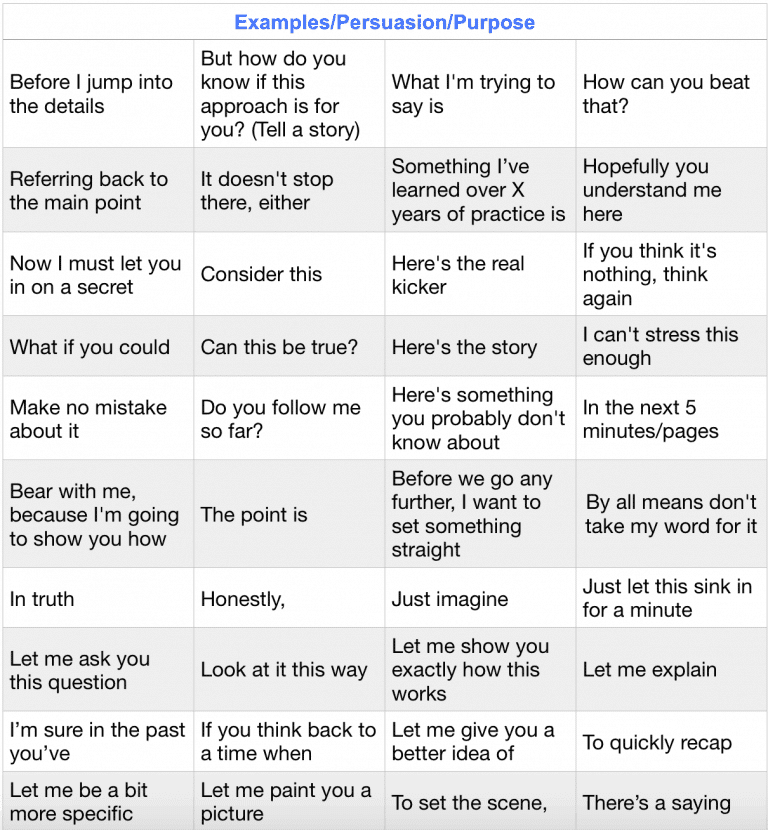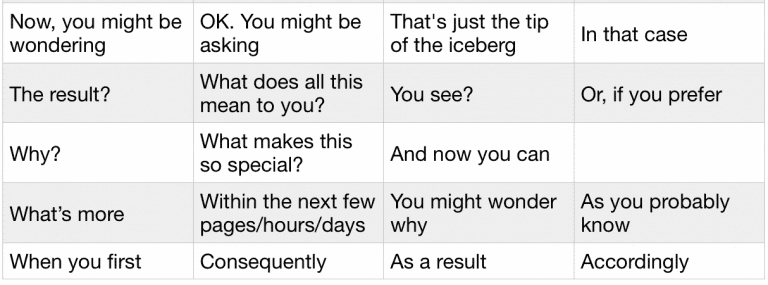Overview
Transition language, transition words or transition phrases are used to link other words, phrases and sentences. They do so in a way that makes the sentence sound human, natural and in flow. Transition language works particularly well in written articles, books and blogs, which would otherwise sound rather robotic. So they’re a powerful addition to your marketing content, which needs to persuade, entertain, engage and inform all at the same time.
I’m sure you’ve read something that simply reported facts, moving abruptly robotically from one sentence to the next. It may have sounded almost Siri-like. As if the sentences were on a supermarket conveyor belt, being checked out one by one.
A great piece of writing, whether you’re writing a book or a blog, needs softening and smoothening out so that your reader can engage more empathetically with the information and keep their focus naturally. As a writer, your job is take your reader’s hand and guide them through the text.

Think of it as you’re leading a tour group through a beautiful location. You slow down the pace when there’s a lot of scenery to take in, and pick it up again when it’s time move on. You’d alter the tone and volume of your voice when describing something epic or dangerous, lower it for something mysterious, change it again for something funny, etc etc etc. The variation in your pace and tone keeps your group interested, present and eager to learn more.
Transition language is this in action within the written word. The longer the text, the greater the need for it. Do still try to include it in even the shortest of articles; it’s part of how you can form bonds with your audience using the written word. It is also a technique you can use to persuade and inform, for example, by starting a sentence with the word ‘yes’.
In the sentence, “Yes, the time passed in a flash”, we don’t know the time in question. But the reinforcement of using the word ‘yes’ first serves to tell your brain that the expectation of the time passing quickly was correct. The first word being ‘yes’ makes you less likely to question the sentence that comes next.

You now accept that the time, in whatever situation is being referred to, passes quickly. This technique is used in many other places in business, of course. Sales and speaking being the obvious two. Getting your audience to think in terms of ‘yes’ makes it less likely they’ll answer a follow-up question with a ‘no’.
To get you started with your own transition language to drastically improve your book draft and blog posts, I’ve included a list of 111 transition words and phrases for you to copy and paste, with table versions for easy reference. Take a look, and let me know how you get on!
Agreement/Addition
(Copy & Paste Version)
1. As you read each word of this page
2. Aside from that, one thing’s certain
3. And that doesn’t take into account the fact that
4. And best of all
5. Incredible, isn’t it?
6. Remember
7. Can you imagine how fantastic that feels?
8. Let’s face it
9. Better yet
10. So you’ll be glad to know
11. So that is why
12. More important than that
13. And in addition to that
14. In light of
15. Also
16. In addition to
17. Uniquely
18. Correspondingly
19. Likewise
20. Equally
21. Moreover
22. Similarly
23. As you may have noticed
24. And that’s not all
25. Here’s some good news for you
26. To prove it, here is

Opposition/Contradiction
(Copy & Paste Version)
27. A word of caution
28. Can you really afford not to
29. Although
30. In reality
31. With that said
32. On the other hand
33. Isn’t it therefore fair to say that
34. The problem I’ve found is
35. It’s not uncommon for others in your position to be
36. On the contrary
37. Besides
38. Despite
39. Regardless
40. Nonetheless
41. Irrespective
42. Conversely
43. Otherwise
44. On the other hand
45. Of course X might be true, but
46. Even so

Examples/Persuasion/Purpose
(Copy & Paste Version)
47. Before I jump into the details
48. Referring back to the main point
49. By all means don’t take my word for it
50. Now I must let you in on a secret
51. Before we go any further, I want to set something straight
52. What if you could
53. Make no mistake about it
54. Bear with me, because I’m going to show you how
55. I’m sure in the past you’ve
56. If you think back to a time when
57. But how do you know if this approach is for you? (Tell a story)
58. It doesn’t stop there, either
59. Consider this
60. Can this be true?
61. Do you follow me so far?
62. The point is
63. What I’m trying to say is
64. Something I’ve learned over X years of practice is
65. Here’s the real kicker
66. Here’s the story
67. Here’s something you probably don’t know about
68. How can you beat that?
69. Hopefully you understand me here
70. If you think it’s nothing, think again
71. I can’t stress this enough
72. In the next 5 minutes/pages
73. In truth
74. Honestly,
75. Just imagine
76. Just let this sink in for a minute
77. Let me ask you this question
78. Look at it this way
79. Let me show you exactly how this works
80. Let me explain
81. Let me give you a better idea of
82. Let me be a bit more specific
83. Let me paint you a picture
84. To set the scene,
85. To quickly recap
86. Now, you might be wondering
87. OK. You might be asking
88. That’s just the tip of the iceberg
89. There’s a saying
90. In that case
91. The result?
92. Why?
93. What does all this mean to you?
94. What’s more
95. What makes this so special?
96. You see?
97. And now you can
98. Or, if you prefer
99. When you first
100. Within the next few pages/hours/days
101. You might wonder why
102. As you probably know
103. Consequently
104. As a result
105. Accordingly
106. For that reason
107. And that’s precisely why
108. In essence
109. Given these points
110. In any case
111. To summarise



To Summarise
As you can see there are loads of simple, handy transition words and phrases you can add to your writing! Hopefully this gets you started. When you get into about it, there are many different transition words and phrases you can quickly add to your content that will add another human layer and make it even more relatable.
I’d love to hear which ones you use. Are there any others not on this list that should be?

The Entrepreneur’s Guide to Book Marketing Success is available to buy through the WBR website and on Amazon and Kindle. It unpacks business book marketing before, during and after publishing, and also includes the 80 of the most popular book marketing strategies.
For more information on our content support available to you, click here to contact us securely or email info@writebusinessresults.com.

Add a Comment
You must be logged in to post a comment